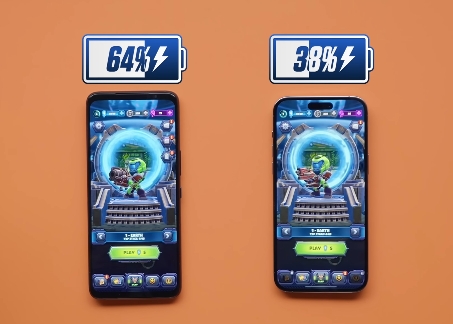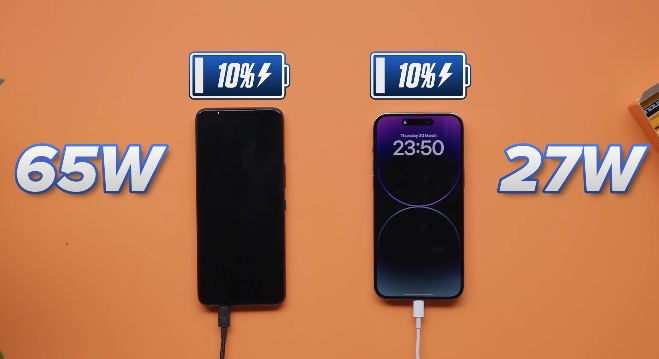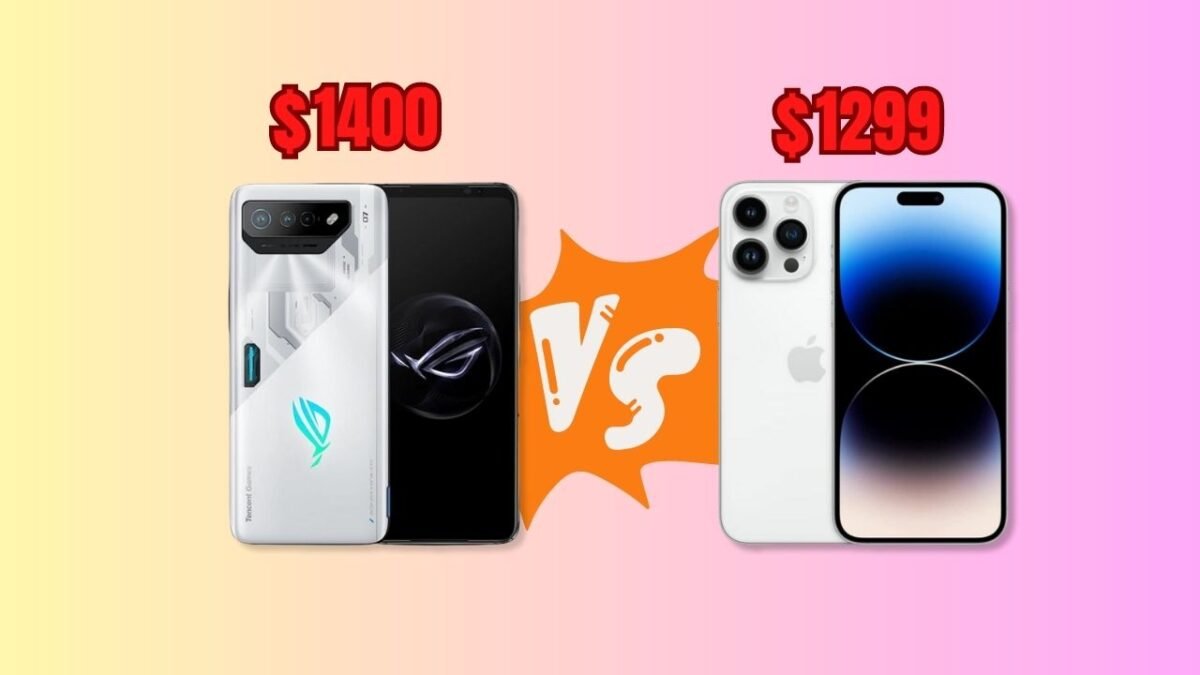Here, we have the Asus Rog Phone 7, which costs $1400 and is touted as the fastest and most extreme Android phone to date. Now, the question arises: Does it surpass the iPhone 14 Pro Max? Is it finally time to compare the Rog Phone 7 vs iPhone 14 Pro Max and determine which one performs better in all aspects, including Camera, battery life, sound, display, and more?
Read Also: Samsung Galaxy S22 Ultra Long-Term Review
Audio Quality
I’ve been thoroughly impressed with the speaker quality on the new iPhone 14 Pro Max. It’s hard to deny that they rank among the best sounding phones available. The combination of the bottom-firing speaker and the front-facing speaker creates a powerful audio experience. However, the Rog Phone 7 takes it to another level entirely. Last year’s Rog Phone 6 already boasted the best phone speakers on the market, and now they’ve enhanced the speaker units to push even more air and deliver booming sound.
The difference is instantly noticeable. The sound from the Asus Rog Phone seems to reach all the way to the Apple bar. It’s remarkable how much superior it is compared to the iPhone. It’s louder, the bass is incredible, and the speaker positioning gives the impression that the sound is directed straight into my ears. But it gets even better with a feature unique to the Asus Rog line.
The company has a history of innovative designs and with each new release they introduce new features. This time, alongside a kickstand, headphone jack, physical buttons, and LEDs, there’s a portal that opens on the phone to pump air directly over the chip itself. And guess what? It doubles as a subwoofer serving as a third speaker dedicated to bass. Just by activating it adds another layer of warmth and richness to the audio. Clearly, the second point goes to the Rog Phone 7.
Battery

So, let’s test arguably the most fundamental phone feature for all of us: the battery. We’ll have both phones side by side. By the way, these are brand new versions of each phone, just to ensure they have 100% battery health. I’ve equalized the brightness and set the speaker volume at 50. Now, let’s see who wins.
The plan is to run straight YouTube videos for the first couple of hours. The iPhone is actually a reasonable amount ahead, possibly because its display can automatically reduce its refresh rate to lower than the Asus Rog Phone can when not needed, thus saving battery. I also believe that part of this difference is due to the fact that Apple’s battery indicator does not show the true battery level. I’m pretty sure iPhones hold on to the first few percentage points to reassure the user that their phone isn’t draining quickly right after being taken off the charger.
We’ll run Instagram and TikTok for another couple of hours. After that, we can start to see the Rog Phone 7 pulling ahead. But what will truly separate the men from the boys is some proper gaming. We’ll run Genshin Impact, Doom, and other demanding games until the phones give up. In the case of the iPhone 14 Pro max, it lasts a total of 9 hours and 30 minutes. I would say that’s towards the upper end of modern smartphones but not the best.
Meanwhile, the Rog Phone is still going strong at around 37%. it took an incredible 12 hours and 18 minutes for the Rog Phone 7 to reach that point, which frankly is insane. And yes, I stood around for 12 hours to get this result.
Charging

I’m only half surprised by the results. I mean, this Rog Phone does have two separate 3000 milliamp hour batteries inside, totaling 6000 milliamp hours, which is a lot more than the other phone. So we might as well test how fast they can charge.
So, I plugged rog phone 7 vs iPhone 14 pro max both phones in using the original charging bricks and cables provided with them. This gives the Rog Phone up to 65 watts of power, while the iPhone technically gets zero watts since it doesn’t come with a charger. However, assuming you pay the extra forty dollars to get the fastest possible charging, the brick can deliver 27 watts of power to an iPhone 14 Pro.
The iPhone is definitely off to a faster start, which might sound strange, but it’s not unheard of. The wattage figure doesn’t tell you the full story because it only represents the maximum charging power the phone can reach, not the power it can sustain during the charging process. Anyway, as soon as the Rog Phone kicks into gear, it quickly catches up and even slightly overtakes the iPhone after just 10 minutes. One thing to consider is that the iPhone has a far smaller battery capacity, only 4300 milliamp hours compared to the Rog Phone 7 6000 milliamp hours. So, there’s less to fill up, and the fact that it’s even close sends a clear message that charging speed is not one of Apple’s strengths.
If we look at the final charging times, the Rog Phone completes its charge in one hour and seven minutes, while the iPhone still has a way to go. So, that’s another point for the Rog Phone 7.
Camera
Well, of course, the Rog Phone wins in all of this. It’s a $1400 phone. But here’s the thing: this phone comes with 512 gigabytes of storage by default. If you go for 512 gigabytes on the iPhone, it’s the same price as rog phone in the US, and actually, the iPhone is much more expensive basically everywhere else. So, surely the iPhone wins in the camera department, right?

Both phones have one front camera and a triple camera setup on the back, and there’s probably not as much difference as you might expect. The Rog Phone 7 captures more natural background blur in selfies, and it’s just as sharp in 98% of situations. It excels in difficult dynamic range situations, arguably better than the iPhone 14 Pro max. Not to mention, it has the power to shoot full 4K slow motion, which goes beyond the 1080p capability of Apple.

However, where the iPhone pulls ahead is in its intelligent processing. The way it identifies and treats faces to make them the center of attention, and how it uses all of its sensors to focus on subjects instantly, even for tricky and challenging objects that most phones would struggle with. Additionally, when it comes to video, the advanced processing required to achieve high-quality results is an area where Apple’s years of refinement truly pay off.
So, the score now stands at 4-1, with the Rog Phone leading in most aspects except for the camera, where the iPhone demonstrates its strengths.
Internet

One thing that I think will be a really interesting experiment between these two phones is their Wi-Fi speeds. On one hand, most of what the average user does on their phone is internet-related, so you would expect the most popular flagship phone to have the internet aspect completely nailed down. However, on the other hand, the Rog Phone is all about shaving off milliseconds of lag when playing online competitive games. So, who actually wins?
Let’s start with the iPhone and run a Google speed test. it’s not too shabby, considering we’re stucked into an attic, with just over 40 megabits per second upload speed. Now, let’s do the same test for the Rog Phone, and there’s an enormous drop-off in comparison. The speed is really slow.
To ensure a more reliable result, I also ran the test 10 more times in a controlled environment. However, there were no consistent trends. The Rog Phone seems to have higher peak speeds, but the iPhone seems to have more consistent speeds, especially when it comes to upload. There’s enough variation that I would call this one a draw.
In conclusion, both phones have their strengths and weaknesses when it comes to Wi-Fi speeds, and it’s hard to declare a clear winner.
Display

But what’s even more important than slightly reduced latency here and there is how good everything actually looks on these screens. They’re both huge displays, although the Rog Phone display is technically slightly larger, you probably wouldn’t notice without a side-by-side comparison. And they’re both better in their own ways.
The Rog Phone 7 has a faster display. You know how phones have been increasing from the standard 60 hertz to 90 hertz and now to the 120 hertz displays that we see on pretty much every 2023 flagship? Well, this phone has a 165 hertz display. Proportionally, that should be nearly as big of a jump as the one between a 60 hertz and a 90 hertz display, which was significant. If you scroll through your home pages and record using a slow-motion camera, you will absolutely notice the difference. It feels like one of those situations where you put in 50% more effort for a 5% more gain. To be honest, at this point, what makes more of a difference is the quality of animations, which Apple really has nailed down.
The Rog Phone does have a second display on the back, although I would say it’s far less useful than the rear displays on most phones that have it. It doesn’t let you preview the camera or check the content of your notifications. It is almost exclusively just for those “Hey, look what my phone can do” moments.
As for the iPhone 14 Pro max, it has a higher peak brightness of 2000 nits compared to 1500 nits on the Rog Phone. This basically covers you for those extra bright outdoor scenes or those extra dark TV shows. The iPhone also features LTPO technology, which allows it to lower its refresh rate all the way down to 1 hertz when not needed. As you’ve seen, this helps save some battery. Additionally, the iPhone has a slightly higher resolution and symmetry. I’m fully aware that the reason the Rog Phone has these top and bottom bezels is that people like something to grip onto when gaming, not to mention to accommodate the massive speakers. So, for me, the iPhone takes the best display.
Performance

Opening with Antutu, which is a very general test that looks at all aspects of your phone and gives you one number to summarize its performance. And for Rog Phone 7 is coming out over 30 percent higher, which is ridiculous. That’s more than a generational lead. I have attached the active cooler onto it, which can apparently cool its surface by up to 25 degrees Celsius and naturally improve its performance. And that’s not completely fair to the iPhone because it’s not being cooled by anything. But then again, the cooler did come in the box, so I feel like it would probably be more unfair to not use it.


Then we’ve got GFX Bench, where we’re just going to focus solely on graphics. The entire reason we even need to run multiple benchmarks, by the way, is that while we all love the idea of just one number that summarizes all performance, actually comparing numbers between Android and iOS is a bit weird because even the benchmarking apps themselves are two different apps built on two different lines of code. That said, if we take multiple tests and see consistent trends that should be enough for us to make a conclusion. It’s going pretty well so far for the Rog, with it finishing this test at almost double the performance. But then, with Geekbench, which focuses on the CPU, the iPhone is ahead, and not by a small margin.
So, to get to the bottom of it we’re just going to run benchmark after benchmark after benchmark until we have a result I’m confident in. Essentially, Apple still has the lead when it comes to the CPU, and no amount of cooling or overclocking on the Rog’s end can make up for that gap. But top-level Android phones currently have a better GPU for gaming, especially helped by this cooling, not to mention faster memory too. So, anything that looks at the overall system performance is going to rank this phone higher, which really makes the category a draw overall.

